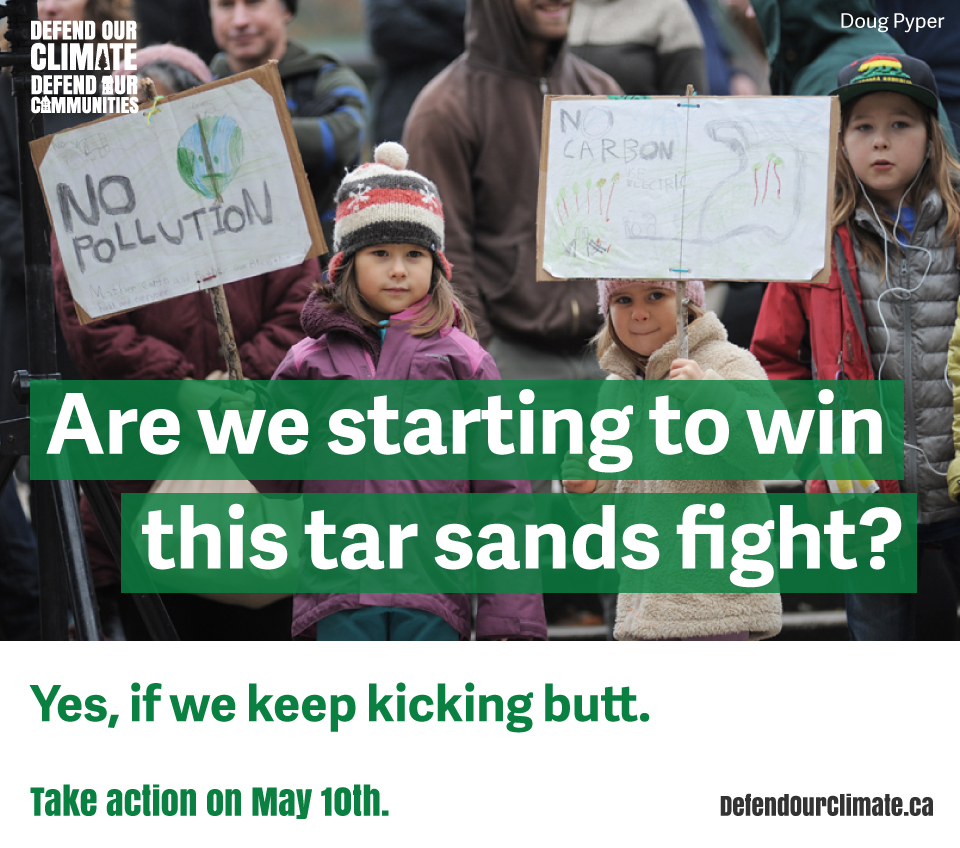I’d be dishonest if I didn’t say working in climate change communications isn’t always the most inspiring place to be. You drink from the firehose of information about the state of the world, the latest science and reports on impacts now and in the future on vulnerable people, how things are happening faster than we predicted and change is slower than necessary, how the elites keep denying and resisting any form of real change, how our window to change is rapidly closing.
Even worse, your job is to “popularize” these devastating, terrifying facts in an effort to move people to action. As a rabble reader you know exactly what I’m talking about. It’s hard to keep a positive outlook when you’re swimming in this soup all day long.
But what if the ground suddenly started to shift?
The last few weeks have put some serious wind in the sails of the climate change movement. Just connect the dots between these events related to Canada’s tar sands:
-
Voters in the blue collar town of Kitimat, B.C. roundly rejected the Enbridge pipeline in a plebiscite, two days after a coalition of First Nations who sit in a quarter of the land Gateway would need to cross said “negotiations are over, this pipeline will not get built”
-
U.S. President Obama just punted Keystone again, indefinitely, the same week this amazing creative action “Cowboys and Indian Alliance” took place outside the White House with massive media attention and Neil Young (again)
-
Each and every week Canada’s brand gets further “tarred” by its steady and (to non-Canadian onlookers) surprising slide towards Petro State behaviour: from this long New York Times Magazine feature from April to Rolling Stone to hundreds of newspapers in the U.S. and around the world the world knows Canada has this giant black eye
-
The increasingly dire reports from the UN on climate are starting to seep in: the world faces a stark choice: keep going on business as usual and face a six degree Celsius rise by the end of this century, all but cooking much of humanity
-
More and more financial analysts and economists are talking seriously about the “carbon bubble”: basically, when the world takes collective action on climate (which we must to survive) high carbon assets like the tar sands will instantly become economically unviable
-
More and more climate, tar sands, and fracking actions continue to happen across both Canada and the U.S. Check out the front page of the Tar Sands Solutions Network website and tell me activists don’t have the momentum now!
Even Liberal Leader Justin Trudeau recently acknowledged the oil sands have become “a poster child for climate change” and that we need to GHG limits for the tar sands.
More Canadians are seeing the pattern
Harper’s government has put all its eggs in one basket: Canada will sustain its economy only by becoming an energy super power driven by the tar sands, and climate change, water pollution, health and cancer risks, wildlife die-offs and massive land destruction be damned.
Harper has handed the keys to the country to the (mostly foreign owned) oil industry, who are rushing to build pipelines in every direction (there are now six giant pipes planned crossing through almost the entire country’s population base and water systems) with no end in sight to tar sands expansion.
But this dark petro-vision is starting to unravel. Mainstream columnists from the Toronto Star to The Globe and Mail are starting to paint a picture for Canadians of how badly Harper has botched the energy files and how his refusal to acknowledge or address climate change is going to keep him getting what he wants.
So when the Harper government announced — on Earth Day no less — they were removing protection of the Humpback Whale from the endangered species list, which was one of the major remaining legal hurdles the Enbridge Gateway pipeline faced, literally dozens of articles have been written.
More and more people are seeing the pattern: attacks on science, re-writing laws specifically for Big Oil, suppressing climate science and attacking anyone who questions their vision as anti-Canadian. And they are rising up and demanding change.
Now we must drive in the last spike
We wouldn’t be here today without a concerted and resilient global and national climate movement, and we won’t take this issue over the top unless the movement keeps growing, keeps choosing bold creative paths forward and keeps notching up some wins.
Last November, thousands of citizens from every corner of the country rose up to join the Defend our Climate, Defend our Communities National Day of Action. Amazingly, over 130 events happened, on the same day with the same message: we need to fight this mad race to build more pipelines and bet our future on an extreme energy path that leads to pollution, death and devastation of our future.
Organizers are once again asking Canadians to rise up at events in their communities, this time on May 10. From Halifax to Montreal to Toronto to Edmonton to Vancouver, rallies big and small will ask Canada’s political leaders to make climate change a priority and take real leadership to defend our communities from it.
As a country we are starting to rise up in a more organized way and say “enough!” Together, we hold more power than the petro-elites and their government cronies. That’s why today I can sense today a palpable sense that “we’re winning” in the air. This sense is like water to a man wandering too long in the desert. Let’s keep the taps open.
Jason Mogus is a senior digital strategist, Leadership fellow with the Broadbent Institute, and one of the organizers behind the May 10 Defend our Climate, Defend our Communities National Day of Action.



